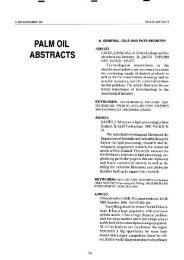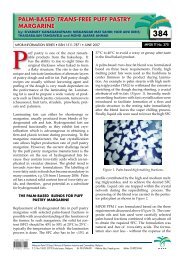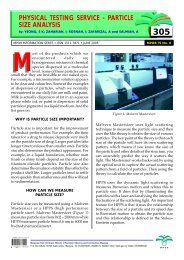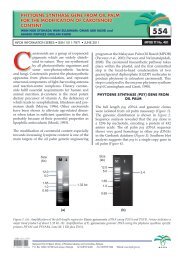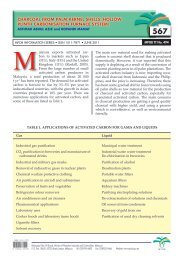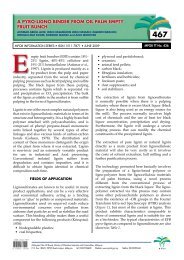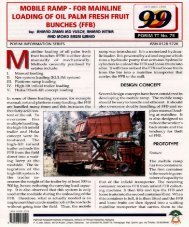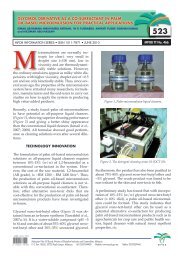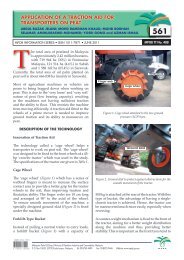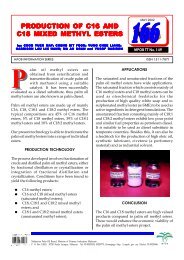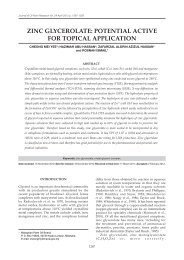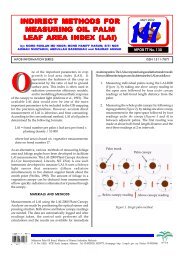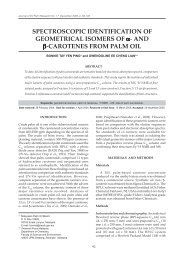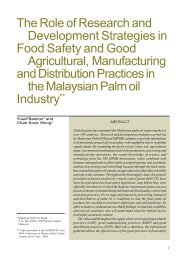uni-slant: unidirectional slanting-hole planting ... - PalmOilis - MPOB
uni-slant: unidirectional slanting-hole planting ... - PalmOilis - MPOB
uni-slant: unidirectional slanting-hole planting ... - PalmOilis - MPOB
Create successful ePaper yourself
Turn your PDF publications into a flip-book with our unique Google optimized e-Paper software.
UNI-SLANT: UNIDIRECTIONAL SLANTING-HOLE<br />
PLANTING TECHNIQUE FOR OIL PALM ON DEEP PEAT<br />
by: HASNOL OTHMAN; AHMAD TARMIZI MOHAMMED and<br />
KHAIRUMAN HASHIM<br />
359<br />
<strong>MPOB</strong> INFORMATION SERIES • ISSN 1511-7871 • JUNE 2007 <strong>MPOB</strong> TT No. 345<br />
Peat (with a total national area of approximately<br />
2.6 million hectares) is a<br />
problem soil (Mutalib et al., 1991). The<br />
inherent physical and chemical properties<br />
of peat make its development<br />
for oil palm cultivation diffi cult and costly. Low bulk<br />
density, high water table and subsidence are among the<br />
major physical properties of peat that need amelioration<br />
for successful cultivation of oil palm. Leaning of the<br />
palms is among the major problems that seriously<br />
affect palm growth and yield, and poses diffi culty to<br />
the management of oil palm on deep peat. Mohd Tayeb<br />
Figure 1. Normal <strong>hole</strong> <strong>planting</strong>.<br />
et al. (1996) reported that the severe leaning of palms<br />
resulted in a sharp early drop in yield, followed by<br />
a slow recovery taking three to fi ve years. Leaning is<br />
infl uenced by several factors, such as land preparation,<br />
<strong>planting</strong> technique, <strong>planting</strong> density, depth of watertable<br />
as well as the peat depth and decomposition<br />
stage. Several workers have worked on overcoming the<br />
problems, especially in land preparation and <strong>planting</strong><br />
(Gurmit et al., 1987; Mohd Tayeb et al., 1996).<br />
FIELD TRIAL<br />
The trial was initiated in 1995 at <strong>MPOB</strong> Research<br />
Station, Sessang, Sarawak. Initially, the peat depths in<br />
the area was 300 to 350 cm, which is considered deep.<br />
The drainage was a system of fi eld drains at every<br />
four <strong>planting</strong> rows, giving an intensity of 340 m ha -1 .<br />
Twelve-month-old seedlings were planted at 160 palms<br />
ha -1 . Fertilizer application and other fi eld operations<br />
followed the normal estate practices. The trial was a<br />
randomized complete block design (RCBD) of split plots<br />
with two replicates. The main plots tested four levels of<br />
soil compaction, viz., 0, 1, 2 and 3 rounds of mechanical,<br />
compaction. The sub-plots tested combinations of four<br />
commercial <strong>planting</strong> materials - P1, P2, P3 and P4 - and<br />
three <strong>planting</strong> techniques - normal <strong>hole</strong> (Figure 1), <strong>hole</strong>in-<strong>hole</strong><br />
(Figure 2) and <strong>slant</strong>ing-<strong>hole</strong> (Figure 3).<br />
FFB yield over a six-year period was recorded for<br />
individual palms by taking their bunch number and<br />
weight, commencing at 36 months after <strong>planting</strong>.<br />
Leaning incidence was recorded every six months and<br />
grouped into three categories:<br />
Mild: Leaning at < 45 o . No serious effect on<br />
palm growth and yield (Figure 4).<br />
Figure 2. Hole-in-<strong>hole</strong> <strong>planting</strong>.<br />
Figure 3. Slanting-<strong>hole</strong> <strong>planting</strong>.<br />
Severe: Leaning angle at > 45 o or toppled.<br />
Serious effect on palm growth and yield<br />
which can take a long time to recover<br />
(Figure 5).<br />
Recovered: Leaning palms becoming erect again<br />
with yield recovered to normal level<br />
(Figure 6).<br />
Malaysian Palm Oil Board, Ministry of Plantation Industries and Commodities, Malaysia<br />
P. O. Box 10620, 50720 Kuala Lumpur, Malaysia. Tel: 03-87694400 Website: http://mpob.gov.my Telefax: 03-89259446
Figure 4. Mild leaning.<br />
Figure 6. Recovered leaning.<br />
Leaning category Incidence<br />
(%)<br />
RESULTS AND DISCUSSION<br />
Effect of Palm Leaning on FFB Yield<br />
The incidence of leaning over 20 years is summarized in<br />
Table 1. Overall, almost 94% of the palms leaned - 29%<br />
mild and 65% severe. Most of the leaning started early<br />
(three to five years after <strong>planting</strong>) and was initially<br />
mild with little effect on the yield. But from 6 to 11<br />
years, more than 50% of the palms leaned severely, and<br />
yielded 9% to 26% less than the upright palms. The<br />
mildly leaning palms suffered less yield loss - less than<br />
9% as compared to the severely leaning ones which lost<br />
15% to 26%. Severe leaning caused a sharp drop in yield<br />
which then recovered slowly as the palms grew upright<br />
again. It seems that leaning and some loss in yield is<br />
inevitable on deep peat. The results indicated that early<br />
leaning will avoid haphazard leaning later on, with less<br />
yield loss.<br />
Effect of Planting Techniques on Incidence of Palm<br />
Leaning<br />
As shown in Table 2, the <strong>planting</strong> technique significantly<br />
affected the incidence of leaning. Over the first nine<br />
years from <strong>planting</strong>, <strong>slant</strong>ing-<strong>hole</strong> <strong>planting</strong> had the<br />
highest incidence of leaning compared to normal <strong>hole</strong><br />
and <strong>hole</strong>-in-<strong>hole</strong> <strong>planting</strong>s. Almost 80% of the palms<br />
planted in <strong>slant</strong>ing <strong>hole</strong>s leaned, 60% mildly and less<br />
than 1% severely. Figure 7 shows that the <strong>slant</strong>ing-<strong>hole</strong><br />
<strong>planting</strong> produced ‘better’ leaning with more than 80%<br />
of the palms leaning in the same direction.<br />
Effect of Planting Techniques on FFB Yield<br />
The effects of the various <strong>planting</strong> techniques on early<br />
FFB yield is summarized in Figure 8. Yield in the first<br />
two years for the <strong>slant</strong>ing-<strong>hole</strong> <strong>planting</strong> technique was<br />
slightly lower than from the other <strong>planting</strong> techniques<br />
TABLE 1. EFFECT OF LEANING ON FFB YIELD (17-year mean)<br />
OF OIL PALM ON DEEP PEAT<br />
FFB yield<br />
(t ha -1 )<br />
FFB yield<br />
reduction (% of<br />
control)<br />
Bunch<br />
production<br />
(palm -1 yr -1 )<br />
Average bunch<br />
weight (kg)<br />
Upright palm (control) 5.8 32.92 - 19.8 12.26<br />
Mild at 3-5 years old 28.5 30.03 8.8 20.2 10.78<br />
Severe at 3-5 years old 10.5 27.99 15.0 19.5 10.51<br />
Severe at 6-8 years old 28.5 26.08 20.8 18.5 10.32<br />
Severe at 9-11 years old 23.5 25.16 23.6 18.3 10.01<br />
Severe at 12-14 years<br />
old<br />
Figure 5. Severe leaning.<br />
3.2 24.51 25.5 17.3 10.23
Incidence of <strong>uni</strong>direction leaning<br />
TABLE 2. EFFECT OF PLANTING TECHNIQUES ON DEEP PEAT ON INCIDENCE OF PALM<br />
LEANING (9-year period)<br />
Planting technique<br />
% of Palms Leaning<br />
Mild Severe Recovered Total<br />
Normal <strong>hole</strong> (S1) 47.3b 1.1a 24.8a 73.2a<br />
Hole-in-<strong>hole</strong> (S2) 50.0b 1.2a 15.7a 63.9b<br />
Slanting-<strong>hole</strong> (S3) 60.2a 0.5a 19.1a 79.8a<br />
Overall mean 51.5 0.9 19.9 72.3<br />
LSD 0.05 7.04 1.00 9.65 8.92<br />
Note: Means with the same letter are not significantly different at p = 0.05 (Duncan’s Test).<br />
Figure 7. Effect of soil compaction on <strong>uni</strong>directional leaning<br />
(9-year period) by oil palm planted on deep peat in <strong>slant</strong>ing<br />
<strong>hole</strong>s.<br />
FFB Yield (t ha -1 )<br />
Level of soil compaction<br />
Year of Harvesting<br />
Normal <strong>hole</strong> Hole-in-<strong>hole</strong> Slanting-<strong>hole</strong><br />
Figure 8. Effect of various <strong>planting</strong> techniques on<br />
early FFB yield.<br />
but improved from year 3 onwards. Overall, the six-year<br />
cumulative FFB yield showed no significant difference<br />
between the <strong>planting</strong> techniques. This suggests that<br />
<strong>slant</strong>ing-<strong>hole</strong> <strong>planting</strong> had no adverse effect on the early<br />
FFB yield compared to the normal <strong>hole</strong> and <strong>hole</strong>-in-<strong>hole</strong><br />
techniques. Although the early FFB yield showed no<br />
significant difference between the <strong>planting</strong> techniques,<br />
in later years the <strong>slant</strong>ing-<strong>hole</strong> <strong>planting</strong> is expected to<br />
give higher yield due to the more even <strong>uni</strong>directional<br />
leaning and earlier palm recovery. The <strong>slant</strong>ing-<strong>hole</strong><br />
<strong>planting</strong> will minimize haphazard leaning and ease<br />
field operations.<br />
ADVANTAGES OF SLANTING-HOLE PLANTING<br />
TECHNIQUE<br />
• Early, progressive and <strong>uni</strong>directional leaning;<br />
• No adverse effect on early FFB yield;<br />
• Minimize FFB yield loss over the long-term, through<br />
even <strong>uni</strong>directional leaning and earlier palm<br />
recovery; and<br />
• Avoid haphazard leaning to facilitate field<br />
operations.<br />
SLANTING-HOLE PLANTING TECHNIQUE<br />
Step 1: Mechanical soil compaction of the <strong>planting</strong><br />
row and harvesting path (Figure 9).<br />
Step 2: Digging of <strong>slant</strong>ing <strong>planting</strong> <strong>hole</strong> either<br />
manually or by using specially-designed<br />
puncher (Figure 10).<br />
Step 3: Planting 12- to 14- month old seedlings (Figure<br />
11).<br />
Step 4: At 24 to 36 months after <strong>planting</strong>, deepen<br />
and widen the side trench for the non-leaning<br />
palms (Figure 12).<br />
Figure 9.<br />
Figure 10.
Figure 11.<br />
Figure 12.<br />
RECOMMENDATION<br />
The <strong>slant</strong>ing-<strong>hole</strong> <strong>planting</strong> technique shows good<br />
promise to minimize the negative effects of palm<br />
leaning on FFB yield and fi eld operations (Figure 13). It<br />
is recommended that this <strong>planting</strong> technique be adopted<br />
for oil palm <strong>planting</strong> in deep peat.<br />
For more information kindly contact:<br />
Director-General<br />
<strong>MPOB</strong><br />
P. O. Box 10620<br />
50720 Kuala Lumpur. Malaysia.<br />
Tel: 03-87694400<br />
Website: http://mpob.gov.my<br />
Telefax: 03-89259446<br />
Figure 13. Slanting-<strong>hole</strong> <strong>planting</strong> technique for a<br />
<strong>uni</strong>directional leaning of palms.<br />
REFERENCES<br />
ABDUL MUTALIB, A; LIM, J S; WONG, M H and<br />
KOONVAI, L (1991). Characterization, distribution and<br />
utilization of peat in Malaysia. Proc. of the International<br />
Symposium on Tropical Peatland (B Y Aminuddin; S L<br />
Tan; B Aziz; J Samy; Z Salmah; H Siti Petimah and S T<br />
Choo eds.). MARDI, Kuala Lumpur. p. 7-16.<br />
GURMIT, S; TAN, Y P; C V RAJAH PADMAN and<br />
LEE, F W (1987). Experinces on the cultivation and<br />
management of oil palms on deep peat in United<br />
Plantations Berhad. The Planter Vol. 63 No. 733: 143-157.<br />
MOHD TAYEB, D; HAMDAN, A B; AHMAD TARMIZI,<br />
M and ROSLAN, A (1996). Recent progress on research<br />
and development on peat for oil palm. Proc. of the 1996<br />
Seminar on Prospect of Oil Palm Planting on Peat in Sarawak<br />
- The Golden Opport<strong>uni</strong>ty (Mohd Tayeb, D ed.). PORIM,<br />
Kuala Lumpur. p. 89-111.



